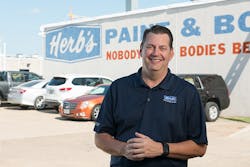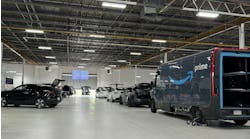ONE: How Herb's Paint & Body Went Up Against the Largest MSOs—and Won
Alan Kirkpatrick's community marketing approach led the family-owned business on an accelerated growth path in a crowded market
Herb’s Paint & Body
Locations: 7 in the Dallas Metro
Size: 14,000-28,000 square feet
Staff: 200
Average Monthly Car Count: 1,300
Annual Revenue: $40 million
Alan Kirkpatrick pauses before answering. He doesn’t like the question—or at least, he doesn’t like the way his answer to the question could be interpreted.
What are the financial gains of everything he and his team at Herb’s Paint & Body do in its Dallas metro market?
The short, factual answer: The gains have been enormous. Since Kirkpatrick first took the helm of the company’s marketing efforts in 1995, Herb’s has more than doubled its number of locations (from three to seven, plus an additional satellite facility). The family-owned MSO will generate more than $40 million in 2016. Each shop operates with a robust double-digit net profit. And each has branded itself so well locally that its customers fail to realize—or admit—that the business could technically be categorized as a chain.
But that’s the answer Kirkpatrick doesn’t like. It misses the point, he says. Sure, his department's work over the last 21 years has helped the company stiff arm its largest competitors in a market that is saturated with Big Four rooftops. All of it has helped the company maintain massive growth year after year, through a recession, through heightened competition, through technological developments in the industry that have caused many to take (at least) a step back before going forward.
“That’s not the way we want to look at it, though,” Kirkpatrick says, doing his best to conceal his dismay over this journalist’s focus on the bottom line. “The fact is, you can’t look at it that way if you want to be successful.
“What it really comes down to is doing the right thing. If we support [our community], our community will support us. It’s been our philosophy long before I came here. This is a 60-year-old business, and it’s built on that simple idea: Do the right thing.”
So, here’s Kirkpatrick’s real answer to the question: The gains, he says, will always be indicative of the effort put in—the results will represent how genuine your business is in pursuing its purpose of helping those in need. This industry isn’t about repairing vehicles, he says, it’s about helping people. Herb’s Paint & Body has become an industry leader in community-focused marketing initiatives. The gains have been large and tangible. But, Kirkpatrick says, this isn’t about him or his marketing department or the business itself. Any shop in any market, regardless of size and scale, can do the same if they truly believe in what they’re doing.
Developing a Consistent Brand
When operating multiple locations, or even just focusing on multiple marketing campaigns, Alan Kirkpatrick says to focus on consistency. As Herb's Paint & Body's executive vice president of business development, Kirkpatrick oversees the marketing for the company's seven repair facilities and single satellite location.
“You can't have inconsistent messages,” he says. “From your uniforms to logos to look in the shops to messaging in promotions to the promotions you choose, it all has to fall in line together.”
For instance, each Herb's location uses the same uniforms, from the tech shirts to the color-coordinated Nike polos of the front office staff to the button-down dress shirts of the managers and executives.
“The little things make a big difference,” he says. “You want to portray the image that you're promoting. It has to match up or customers won't trust what they see or hear.”
What Do You Believe?
As mentioned, Kirkpatrick joined Herb’s in 1995. The company’s dedication to its community started long before that, though. The original owner, Herb Walne, set the tone when he founded the company in 1956 as a service center operating out of a Humble gas station. Herb not only quickly built an impressive business, but also built a reputation for fair, honest service, and became a leader in the community. He was a Dallas city councilman. He served on the boards of directors for hospitals and the parks service, and instilled a “service” mentality in all who worked for him.
That included his son, Alan, and grandson, Robert. Alan Walne, who also at one point was a city councilman, serves as the company’s chairman today; Robert Walne is its acting president and COO.
“Herb had passed away before I started here,” Kirkpatrick says, “but I grew up in this area and knew the reputation. I knew that that was what we had to carry on.”
Kirkpatrick, the company’s executive vice president of business development, was quickly given reins to the Herb’s marketing machine when he was first hired. He took a simple approach.
“Everything just needs to reflect who we are and what we believe in,” he says. “We want to do the right thing to help our community. Our slogan today and our vision says ‘Making Unpleasant Experiences Pleasant Ones.’ That’s what we want to do.”
And that’s the foundation for successful marketing, Kirkpatrick says. Marketing can only be effective if it’s genuine, and the way to ensure it’s genuine is to understand who you are as a company and always pursue initiatives that align with that.
How Do You Get It Across?
Overall, Kirkpatrick’s marketing goal is brand awareness. Everyone knows the statistic: The average customer gets in an accident once every seven years. That means two things, Kirkpatrick says. One, your business needs to make every customer experience a great one to ensure the customer remembers you; and two, your business needs to have an impact outside of its facilities to ensure that new customers will think of you at the time of an accident. Name recognition is the key, he adds.
There are two simple steps to doing this.
1. Choose the Right Cause. Each of the Herb’s Paint & Body facilities has a general manager who operates with a significant amount of autonomy.
“We want them to build their local stores and have them feel like local stores,” Kirkpatrick says. “They have to have the ability to make decisions and do what’s best for their specific markets.”
The marketing campaigns ultimately go through Kirkpatrick and one other full-time employee dedicated to marketing at the corporate headquarters. But the focus of each initiative, and identifying the important needs of the community fall on the local operator.
“We offer approval and guidance and help with the logistics and financing,” he explains. “But we want projects that they are passionate about and that will impact their local communities. If they believe in it, it’ll succeed.”
2. Carry Out the Proper Campaign. One of the company’s most successful community marketing campaigns has come from the Herb’s Frisco location. Its manager wanted to help support local charities and organizations through hosting events. But how could the Frisco shop stand out? What could it do to add its personal touch to each event?
“Well, our [manager] there loves barbecue and loves grilling out,” Kirkpatrick explains. “So, that led to the idea of creating this large barbecue trailer that we can take places and host a cookout.”
These aren’t ordinary cookouts, mind you; Kirkpatrick says they normally opt for “higher-end” options. For one event supporting the local child advocacy center, the company grilled steak and chicken for close to 500 people. Kirkpatrick says the tab usually comes out to roughly $10 per attendee. It might sound steep at first, but if even a small fraction of that group winds up as customers some day, the ROI is significant.
Another location has supported a local cheerleading team that sells T-shirts each year—10 percent of proceeds goes to a charitable cause; the rest goes to funding the cheerleading program.
“That’s another great example: We put our logo on the back of the shirts and donate all of them to the team to sell,” Kirkpatrick says. “It’s usually 5,000 T-shirts each year. I can’t tell you how many people I’ve seen in the shop that say they always see our names on those T-shirts around town.
“There are a lot of examples like that from our shops. Some change it up every so often. Those two examples are year after year. They’re programs that really support our communities but also help us get our name out there connected to some great causes that we believe in.”
Build Brand Ambassadors
Successful marketing begins and ends with your team, Alan Kirkpatrick of Herb's Paint & Body explains. If you don't have staff that believes in your mission and follows it each day, then your business cannot succeed.
There are many ways to turn staff into brand ambassadors, but Kirkpatrick says one of his favorite is employee recognition. Herb's goes to great lengths to recognize and thank employees to let them know their efforts are appreciated.
When It All Adds Up
Like Kirkpatrick says, Herb’s has always focused on supporting its local communities. But it was about 10 years ago that this became a more focused and processed effort on the part of the company’s marketing team. Since then, the company has created an offshoot website from its company home page that singles out its work in its communities. HerbsCares.com provides an easy-to-find listing of each campaign and also increases the company’s search engine performance. The site also gives the option for customers to request for support for certain local initiatives.
“It’s a great way to start that communication process,” Kirkpatrick says. “It gets our good work out there, but it also allows us to connect with what’s important to our customers.”
Everything Kirkpatrick has mentioned in this piece doesn’t require a huge budget, facility, or staff. Herb’s uses a marketing budget that is roughly 4–5 percent of its total sales volume; that’s a typical benchmark suggested by many industry consultants.
“In our markets, we compete with people with much deeper pockets; we have all of the largest companies right in our markets,” he says. “But we look at it as, if we can capture the heart of the community, they’ll know who supports them in a time of need.”
The success of each campaign can be measured in growth—and Herb’s has grown immensely over the years, and is on pace to continue that trend. But, that’s not how Kirkpatrick looks at it. What are the gains that come from what Herb’s Paint & Body does in its Dallas metro market? That’s not the right question, Kirkpatrick says.
“I think of it more as, ‘What would happen if we didn’t? What kind of company would that make us? What would that say about how we value our community and our customers?’” he says. “Our company is focused on doing the right thing. And that’s what we’re going to continue to do.”
TWO: How Grant Sunday Got Employees Invested in Shop Growth
When change created backlash, Sunday stuck to his plan and transformed Don's Body Shop
Don’s Body Shop
Location: Olathe, Kan.
Size: 10,000 square feet
Staff: 15
Average Monthly Car Count: 110
Annual Revenue: $2.8 million
Change doesn’t come easy, and Grant Sunday, owner of Don’s Body Shop in Olathe, Kan., can attest to that: Transforming the modestly performing shop into the $2.8-million business it is today meant losing all 10 of his inherited employees and hiring 13 of his own.
Yet, Sunday says it’s been a blessing to slowly build his new staff over the past six years, as he’s been given the opportunity to hire people who buy into his vision for success—and he credits his ability to find great employees to a few key shop changes.
“Everyone here is really happy with how we work,” Sunday says of the new staff. “They’re used to the change now, and they’re committed to getting better and better each day.”
In his quest to make Don’s Body Shop a more pleasant place to work, Sunday has discovered what employee-focused attributes are necessary for getting new staff members invested in the shop’s future.
Organize the scheduling process. The general mood of your shop culture is dictated by the working environment, Sunday says. When he came in, he sought to first fix the chaotic scheduling process, which was causing stress and arguments. Now, each day’s schedule for the entire shop is laid out a daily morning meeting.
“It starts with the front office, making time for appointments, drop-offs, scheduling cars,” he says. “We’re fine with losing work if it means not overloading our guys in the back. It’s a necessity for us to plan out our days and weeks, scheduling the drop-off and pick-up date beforehand, and having our back-end estimator manage jobs and keep them organized and on time.”
Craft an aesthetically pleasing shop. Brown … quite possibly the world’s ugliest color, Sunday says. And—in addition to old bolts and worn-out light bulbs—brown was all over the walls, beams and ceiling of Don’s Body Shop six years ago. Changing that dire look was essential for altering employees’ collective mood, Sunday says.
“I created this blueprint of what this shop was going to look like, and it consisted of painting the inside of the shop white and re-lighting it with T8 light bulbs,” he says.
Update your equipment. For employees to really excel, Sunday felt it was necessary to provide the proper tools. As his first order of business, Sunday bought a new paint booth, upgraded to electronic measuring equipment, and bought a Pro Spot welder for his technicians.
Get everyone involved in philanthropy. Perhaps Sunday’s most pivotal addition has been increased community involvement. Whether it’s helping Cub Scouts build pinewood derby cars, restoring vehicles for veterans, hosting firefighter training on shop grounds, or providing internships for students at the Kansas School for the Deaf, Sunday says his staff has embraced representing Don’s Body Shop and giving back to the community whenever possible.
“That’s huge, when your people are truly proud of where they work,” he says. “They feel like they’re part of something bigger and really making a difference.”
THREE: How Eugene Cortes Built his Business Around the Customer
Twenty-five years of improving the customer experience culminates with Cortes' new management system
Clarkstown International Collision
Location: Nanuet, N.Y.
Size: 14,000 square feet
Staff: 32
Average Monthly Car Count: 200
Annual Revenue: $7 million
If you ask Eugene Cortes about his key to success, he gives a pretty simple answer:
“It all boils down to customer service.”
But that’s not just some statement Cortes throws out—he says it with a mix of compassion, sincerity and gravity that comes with 40 years of collision repair experience.
Plus, his approach to providing exemplary customer service has been anything but simple. For every decision he’s made since opening Clarkstown International Collision in Nanuet, N.Y., he’s started by putting himself in the customers’ shoes, considering how their experience will be shaped entirely by how attentive he is to their needs.
“They’ve just had their beautiful, brand-new car damaged,” he explains. “When you’re on their level and understand how they feel and you show that it’s not just about getting the job in the door, people appreciate that.”
Starting with just three employees 24 years ago, Cortes has built Clarkstown International Collision into the current 14,000-square-foot, $7-million facility by focusing on what he believes are the essentials for improving customer service. Those components were the basis for his newly invented, customer-focused management system program, The Traffic Report, which he has been implementing at his own shop over the past five years.
Give off a professional appearance. It might sound simple, but an organized front office goes a long way. Cortes says his shop gives off a very professional vibe with a clean, spacious lobby, comfortable furniture, wall-mounted televisions, updated magazines, certifications on the wall, and a dress code.
Offer customer service training. Training for front office staff is as essential as training for technicians, Cortes says. In addition to paying for training courses, Cortes will spend time with staff members, going over best practices for putting the customer at ease.
Show that you care. Saying you care about the customer is one thing—showing you care involves engaging with customers, even when they’re unbelievably stressed.
Front office staff is trained to ask questions—“How are you? How are you feeling? Do you need glass of water?—and offer comfort phrases, such as, “Don’t worry about the car—it’s only metal, and that can be replaced.”
Build confidence through shop tours. Getting customers to buy into your message isn’t always easy, but Cortes says that by showing them your repair process in a live setting, you can start to inherit their confidence.
“When we’re writing an estimate, we give them a tour to show them the process of repairs,” he says. “We tell them, ‘At any time that your car is being repaired and you'd like to come over, we'll be more than glad to show you the car.’”
Respond to customer surveys. Cortes pays a company to send post-repair surveys to customers, which have provided him crucial insight into Clarkstown’s customer service.
“I’m always interested in the negative responses, not the positive ones,” he says. “If I see a negative one, I will call the customer, and they’re usually shocked. They never expect an owner to care that much.”



